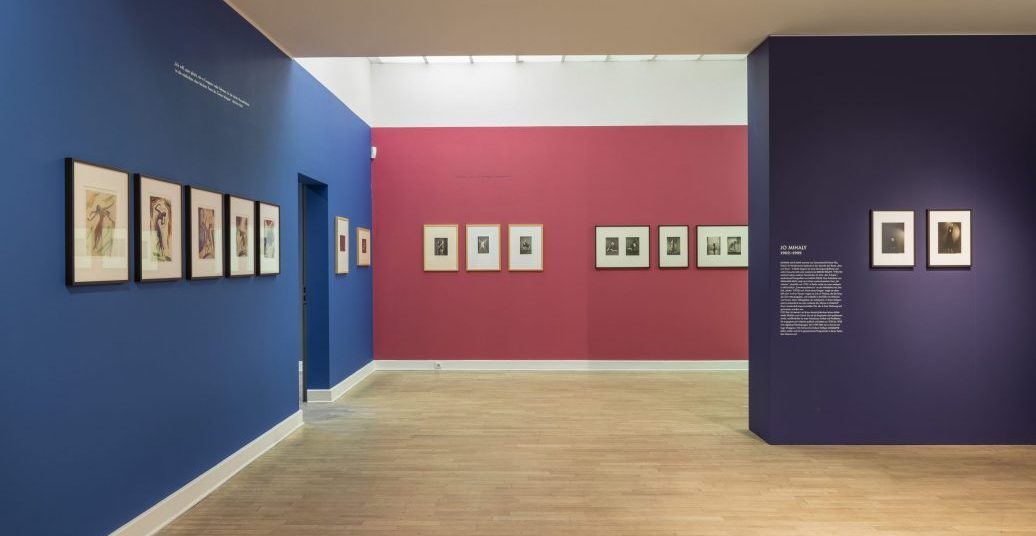On 23 April, the exhibit “The Absolute Dance. Female Dancers in the Weimar Republic” (April to August 2021) opened at the Georg Kolbe Museum in Berlin Westend with a preview for experts and journalists. Curated by Dr. Julia Wallner and Brygida Ochaim, the exhibit corresponds with the scenographic design and the work “Blaue und Gelbe Schatten (Blue and Yellow Shadows)“ by Ulla von Brandenburg.
Update: The exhibition has been extended until 17 October 2021.
“We dance death, pregnancy, syphilis, madness, dying, infirmity, suicide, and no one takes us seriously. They merely gawk at our veils to see if they can discern what is beneath them.” (Quote from the exhibit)
This shocking acknowledgement by Anita Berber, one of the scandalous icons of the 1920s dance scene who died in Berlin at just 29 years of age from tuberculosis, can be construed as a concise expression of the Weimar Republic zeitgeist. During the brief period between the explosion of World War I and the catastrophe of World War II, a generation of young female dancers in Berlin rebelled mercilessly and ecstatically against aesthetic conventions, portrayals, and patriarchal power structures of a world order, which irrevocably collapsed before their very eyes. In the atmosphere of the failed November Revolution of 1919, escalating ideological antagonism, and the anticipation of the horrors of the Nazi era, an artistic revolution occured, one in which the choreographic works of women in particular – as the Kolbe Museum exhibit reveals – played a defining role, one which should not be underestimated. Considering that the history of performing arts in the Weimar era is primarily associated with works and names like Max Reinhardt, Erwin Piscator, and Bertolt Brecht, the significance and importance of female choreographers and dancers of this period still appear to be a largely unexplored phenomenon. By drawing attention to biographies and works largely unfamiliar to a broader audience, curators Dr. Julia Wallner and Brygida Ochaim shed new light on the blind spots in cultural history. As such, the exhibit makes a groundbreaking contribution to future, gender-critical debates regarding 1920s art and helps us rewrite the canon of dance history.
“The Absolute Dance” uses a number of photographs, films, sculptures, quotations, posters, drawings, and sketches from various archives and collections to reconstruct the positions and styles of eleven female artists: Valeska Gert, Anita Berber, Hertha Feist, Vera Skoronel, Berthe Trümpy, Charlotte Bara, Tatjana Barbakoff, Claire Bauroff, Jo Mihaly, Oda Schottmüller, and Celly de Rheidt. If one were to seek out that curatorial gesture, which determines the leitmotif and concept of the exhibition, it would be the intermedial dialogue between dance, sculpture, painting, photography, and film. The dancing and choreographic figures are perceived in the field of expanded media constellations, whereby a differentiated glimpse at the self-portrayal of the Weimar Republic dancers is made possible. One can also observe the effectiveness of a deliberate, contemporary dialogue between curatorial concept and spatial works vis-a-vis the staging of the artifacts in the exhibition. Ulla von Brandenburg’s spatial design defines the scenography of the exhibit using colorful walls to allow for a dynamic interplay between bodies, color, architecture, and the vestiges of dance on display. These stage designing elements emphasize the sensual-physical perception, which turns the visit itself into a choreography and embeds the afterlife of dance in the viewer’s own body. The traces of the performance of Ulla von Brandenburg’s “Blue and Yellow Shadows” (performed on 23 April 2021), which are installed in Kolbe’s large studio in the form of white sculptural objects, as well as the vast monochromatic textiles (which appear like curtains and are also a part of her work) join the hidden space-time of absolute dance to the curious ambling of visitors. In this game between absence and presence, reconstruction and realization, one encounters objects and movements, which continue to vibrate and shift the archive away from a finalized past and towards an open potentiality in the future.
English translation by Melissa Maldonado
Note: In accordance with the Infection Protection Act, the museum is currently closed. The exhibition “The Absolute Dance. Female Dancers in the Weimar Republic” runs until 29 August 2021. You can find updated information regarding your visit under Corona conditions on the Georg Kolbe Museum website.
Update 19 May 2021: The museum is once again open!




